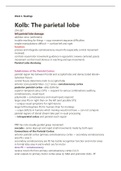Samenvatting
Summary 3.6C Neuropsychology
- Vak
- Neuropsychology
- Instelling
- Erasmus Universiteit Rotterdam (EUR)
If you are looking for a high-quality study summary document that provides a concise and informative overview of Neuropsychology look no further ! My study summary notes are easily understandable. l provide you with all the necessary knowledge you need to master your exam I try to form comple...
[Meer zien]




